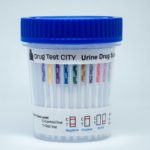
MTD on a Drug Test stands for Methadone.
When parents and employers purchase drug tests they usually recognize the abbreviations for common illicit drugs such as THC for Marijuana. It is common for one or two abbreviations to stump them. Methadone is not a gateway drug, it is primarily used for Methadone Maintenance Treatment. Methadone is almost always included on 12 panel drug tests.
What is MTD on a Drug Test?
MTD stands for Methadone. Methadone (MTD) is an opioid originally developed as a treatment for pain during World War II by German scientists Gustav Ehrhart and Max Brockmuhl. It was developed as part of a program aimed at easing the demand on the raw materials used in morphine production.
Originally patented under the trade name Dolophine, Methadone (MTD) is still used as a maintenance pain reliever often prescribed in conjunction with other opioids for breakthrough pain. It is thought to be more effective against neuropathic pain and takes longer to build a tolerance to because of its inactivity on the NMDA receptor.

Since the 1970s Methadone (MTD) has been used in detoxification and opiate maintenance programs.
The half life and effects of Methadone (MTD) are significantly longer than other opioids. Persons addicted to heroin or other opiate based painkillers can often substitute Methadone and live productive and fulfilling lives.
Methadone (MTD) is widely used as a detox drug in hospitals. Some Medical Doctors prefer Morphine because Methadone’s withdrawal symptoms are protracted and it’s sometimes harder on the patient. Methadone maintenance programs are controversial, but almost all patients that are successful in a maintenance program say that it has dramatically improved their life.
Methadone (MTD) is a schedule II drug in the United States.
Methadone (MTD) Test Detection Time
In a presumptive urine drug screen the detection time for Methadone can vary from 3-9 days depending on use and the patient’s metabolism.
Side Effects of Methadone
- Sedation
- Constipation
- Flushing
- Sweating
- Heat intolerance
- Dizziness or fainting
- Light Headedness
- Weakness
- Chronic fatigue, sleepiness and exhaustion
- Sleep problems such as drowsiness,trouble falling asleep (Insomnia),and trouble staying asleep
- Constricted pupils
- Dry mouth
- Nausea and vomiting
- Low blood pressure
- Hallucinations or confusion
- Headache
- Chest Pain
- Elevated Heart Rate
- Abnormal heart rhythms
- Slow or shallow breathing
- Loss of appetite
- Weight loss
- Weight gain
- Memory loss
- Trouble Focusing
- Stomach pains
- Itching
- Difficulty urinating
- Swelling of the hands, arms, feet, and legs
- Restlesssness
- Mood swings
- Euphoria
- Disorientation
- Anxiety
- Blurred vision
- Decreased libido
- Skin rash
- Seizures
- Sleep apnea
Additional Precautions
As a drug used in maintenance programs Methadone (MTD) is often prescribed in high dosages and is mixed with water by the dispensing clinic. There have been several instances of children being poisoned by consuming medicine that was meant for their parent.
Methadone can also be prescribed as a liquid. Larger Methadone clinics dispense flavored liquid that is similar to a dose of cough syrup.
Sources:
Nicholson, AB. October 2007. “Methadone For Cancer Pain”

